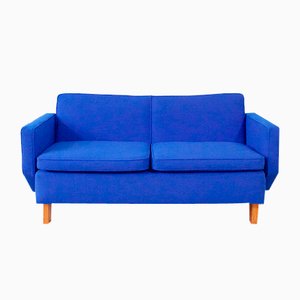
Finnish architects Alvar (1898-1976) and Aino Aalto (1894-1949), married in 1925, were early proponents of modernism in Scandinavia. In the late 1920s and early 1930s, they began to develop designs, from buildings and interiors to furniture and objects, characterized by innovative, streamlined forms and state-of-the-art materials and processes. The Aaltos’ work—as expressed, for example, in the curvilinear, bent plywood Paimio Chair, created for their Paimio Tuberculosis Sanatoriam (1928-1933)—quickly came to be seen among the international design cognoscenti as a humanistic antidote to the “cold” steel-and-glass designs associated with German, Bauhausian modernism. Following a series of successful exhibitions abroad, especially at Milan’s influential Triennale expo in 1933, the Aaltos and their furniture were in high demand. In 1935, with the help of art critic and future CEO Nils-Gustav Hahl (1904-1941) and art patron Maire Gullichsen (1907-1990), the Aaltos launched Artek in Helsinki, not only to sell and market their furniture, but also “to promote a modern culture of living by exhibitions and other educational means.”
Until the 1950s, the Aaltos designed most of Artek’s products—most notably their Stool 60 (1933), Screen 100 (1936), Tea Trolley 901 (1936), and Stool Y61 (1947). In the years after the war, however, the brand began collaborating with impressive Finnish designers like Ilmari Tapiovaara, whose Mademoiselle Chairs (1956) are still a best-seller today; and Tapio Wirkkala, whose ’60s-era glass pendants were put back into production in recent years. Artek’s collaborations in the 21st-century have included major international designers like Konstantin Grcic, Hella Jongerius, and the Bouroullec Brothers. In 2007, the company commissioned Japanese architect Shigeru Ban to design a pavilion; titled The Space of Silence, the project travelled to multiple destinations around the globe.
Since 2013, Artek has been owned by the German brand Vitra, with offices in Helsinki, Berlin, Stockholm, Tokyo, and New York. Artek’s designs are included in institutional collections around the world, including New York’s Museum of Modern Art, Weil am Rhein’s Vitra Design Museum, and London Design Museum, as well as The Alvar Aalto Museum in Jyväskylä and Helsinki.
* All images courtesy of Artek

